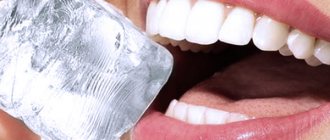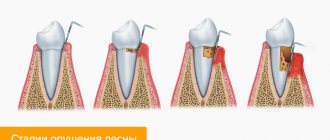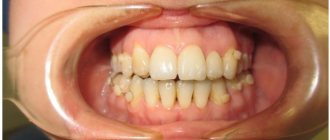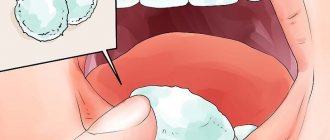Teeth can hurt for various reasons. Often toothache occurs from cold. The following factors influence dental hypothermia:
- The tooth is affected by caries or an inflammatory process has begun in the deep layers of dental tissue and affected the nerve. If the immune system is weakened, the nerve may become inflamed from the cold.
- Cold causes active activity of pathogenic bacteria.
- Due to hypothermia, pathogenic bacteria begin to multiply intensively in the nasal cavities. The inflammatory process can spread from the nose to the teeth. Cold is a favorable environment for the life of pathogenic microorganisms.
- If inflammation of the trigeminal nerve occurs from hypothermia, it is difficult to distinguish it from dental diseases.
- Herpes, which occurs on the lips from hypothermia, can cause inflammation of the nerve endings of the teeth.
Why can teeth react to cold?
There are many reasons why discomfort and pain may occur when drinking cold or hot drinks or food. Most of them are directly related to diseases of the oral cavity, but there are also those that are not directly related to dental pathologies:
- Damage to tooth enamel.
Violation of the integrity of the outer covering of the tooth can be caused by a variety of reasons: frequent consumption of hard and dry food, which scratches the enamel during chewing; - mechanical chips;
- an incorrectly selected toothbrush (doctors recommend using medium-hard brushes for adults and soft-bristled brushes for children);
- eating foods that can negatively affect the condition of enamel (carbonated sweet drinks, sour fruits, food additives, etc.).
is one of the most common causes. The fact is that most people don't even think about the fact that they have tooth decay until a distinct black spot appears on the tooth. In fact, caries in the early stages can only be distinguished by an experienced dentist - a tiny gray dot (and this is what “young” caries looks like), if it is not examined in time and urgent measures are not taken to eliminate it, it first becomes the cause of increased sensitivity, and then acute pain.
. Untreated caries invariably leads to another, even more serious disease - pulpitis - destruction of the soft tissues of the tooth. Naturally, with pulpitis, the dental nerves are exposed, which causes acute pain when eating cold, hot, sweet or sour food.
. If the gums become inflamed, in most cases the subgingival part of the tooth, the dentin, is exposed. Dentin is completely devoid of a protective layer - enamel - therefore, at the slightest contact with cold water, food, or even just cold street air, patients invariably experience discomfort and pain.
If you suspect one of the above reasons, you should not delay visiting the dentist for long - an experienced specialist will quickly identify the problem and prescribe a course of treatment.
Reasons not related to oral diseases include the following:
- any hormonal disorders
and changes in the body. As a rule, such conditions occur while taking hormonal drugs, oral contraceptives, during pregnancy or breastfeeding; - suffered nervous shocks
, life in a state of constant stress, etc.; - deficiency of vitamins
, minerals and nutrients in the body. “Seasonal” sensitivity can often occur - when in spring and autumn, due to vitamin deficiency, many patients begin to complain of a certain discomfort after taking cold or hot; - damage to the immune system
, viral diseases; - endocrine diseases
(disorder of one or more endocrine glands).
If increased tooth sensitivity is caused by these particular pathological conditions, then no special dental treatment is required - the main treatment should be aimed at eliminating the root cause.
If, after a serving of ice cream or a glass of cold juice, you suddenly feel discomfort, which smoothly turns into acute pain, it is quite acceptable to take a tablet of a pain reliever that is suitable for you - this can be Nimessil (powder for dissolving in warm water), Aertal (tablets), Ketonov , Dexalgin.
Tooth hurts after filling
Author of the article: Kondratyeva Tatyana Yuryevna Dentist therapist of the Highest category
This is a very common question on the Internet. Indeed, if a tooth hurts before visiting the dentist, this is understandable, but when the tooth is cured and still hurts...???! Today I will talk about the most common causes of such pain.
If you apply for complicated caries (pulpitis or periodontitis), then treatment ends with filling the canals. We have already talked about the complex anatomy of the canals, so it is difficult to process them, wash them, and get to the smallest branches where microbes can “sit.” And the procedure for removing the nerve itself is associated with trauma, because the doctor has to “cut off” the neurovascular bundle at the apex of the root. As a result, swelling and aseptic inflammation form in the tissues surrounding the root, which the patient feels as pain when biting. If the swelling in the periodontal fissure is significant, then the patient has the feeling of an “overgrown tooth.”
If a living nerve is preserved in one of the branches of the canals, then pain occurs from hot food (although sometimes the inflamed gums also hurt from hot food). Well, if the inflammation that began inside the tooth, despite its treatment, still continues, and this depends on the body’s resistance and on the load on the tooth (let’s assume the patient has significant loss of teeth and needs prosthetics), then a situation arises when an abscess (ulcer) forms, which is opened surgically, and the inflammation is extinguished with the help of antibiotics.
In any case, the less of these sensations the better the quality of canal treatment and filling.
The tooth may hurt even after treatment of uncomplicated caries. So, after treatment of deep caries, sometimes nighttime, spontaneous and long-lasting pain occurs from cold, and then from hot. With such complaints we are already talking about pulpitis. The fact is that the diagnosis of deep caries and the chronic form of pulpitis, when there are no complaints, is practically indistinguishable. After all, what caries is is destroyed tooth tissue stuffed with microbes. And if the cavity is deep, then the infection comes close to the nerve.
All dental therapists are great optimists and are always determined to keep the tooth alive and more functional. Indeed, the idea of removing, say, a finger if it starts to hurt doesn’t occur to anyone??!! Such deep cavities are treated with the application of therapeutic pads, observing the rules of asepsis and antisepsis, and the patient is warned about the possible removal of the nerve subsequently.
After caries treatment, pain sometimes occurs when biting at a certain point.
It happens :
A) if the filling is too high and under anesthesia the patient cannot perform the entire range of movements of the lower jaw, which enable the doctor to grind the filling so that it does not interfere.
B) if post-polymerization stress phenomena occur. The fact is that modern filling materials, light-curing composites, have one negative property (with many positive ones!!!) this is polymerization shrinkage.
In other words, during the curing of the composite, the filling decreases in volume, and since the adhesive bond glues the filling so strongly to the walls of the tooth, they (the walls) begin to experience stress. Moreover, this force is so great that the enamel cracks and first a microscopic gap is formed around the filling, and then quite a significant one. Some patients may have noticed that a matte white stripe first forms around the filling, and then a brown one; this happens when food pigments stain the imperfections around the filling.
One of the reasons for tooth pain after filling is enamel stress
Sometimes these pains are associated with the formation of this microscopic gap under the filling, at the bottom of the carious cavity, or the formation of a pore, a tiny air bubble, in the thickness of the filling, which can form during plastic processing of the composite. In this case, chewing pressure is inadequately transmitted to the pulp and pain occurs. The same symptoms appear if the adhesive, for one reason or another, fails to saturate the tooth tissue well and sensitive areas remain unsealed, causing patients pain when exerting themselves.
C) sometimes after treatment there is sensitivity from cold and discomfort when touching, say with a toothbrush, certain areas of the enamel. Then we talk about superficial sensitivity or hyperesthesia.
Treatment of a tooth involves its preparation with burs, numerous washings, treatment with acids, drying, polishing with abrasive pastes, heating, pleasure, the list of all effects on the tooth is not yet complete. Therefore, sometimes sensitive people with sensitive teeth experience such symptoms. After reading this article, do you get the impression that dental treatment is harmful? I want to reassure you and inspire optimism: for a high quality of life and general health, you need to have beautiful, healthy teeth, which means you need to care for them, treat them, and clean them! And competent specialists, professional dentists who have good equipment, modern technologies and materials, the desire and ability to help you, our dear patients, will help you with this.
Do you have any questions? Get an answer right now using the “Ask a question” form. We will be happy to help you.
»
Reaction to cold after dental procedures
Often the cause of a sudden reaction of teeth to cold or hot is recent dental procedures:
- Whitening. In order to understand how this very popular procedure today affects tooth sensitivity, let us recall that whitening (especially done at home or in a suspicious clinic by an inexperienced doctor) can cause severe thinning of tooth enamel. Needless to say, abuse of the procedure invariably leads to damage to the enamel and, accordingly, causes hyperesthesia.
By the way, frequent use of highly abrasive whitening toothpastes can lead to teeth reacting to cold or hot temperatures. If you prefer to use whitening pastes, choose gentle and gentle preparations.If increased sensitivity is the result of excessive whitening, you should first stop using abrasive pastes and contact your dentist to undergo a fluoridation or remineralization procedure.
- Sealing . Most often, after conventional therapeutic treatment of deep caries or pulpitis, patients experience increased tooth sensitivity. The reason for this is the effect on the pulp and nerve endings, after which it is not recommended to drink cold or hot for a few more days. As a rule, there is no acute pain, so the patient can easily cope with the discomfort. If it suddenly turns out that after 2-3 days the sensitivity does not disappear, the discomfort gradually turns into pain, you need to urgently consult a doctor - perhaps an inflammatory process has begun, which needs to be eliminated as soon as possible.
- Prosthetics . During the installation of fixed or removable dentures, tooth enamel can also be damaged.
It is rarely possible to avoid hypersensitivity after dental procedures, so it is recommended to minimize the consumption of cold or hot drinks, ice cream, hot food, etc.
Why does a dead tooth react to cold?
Increased tooth sensitivity is the result of irritation of nerve endings. Accordingly, after removal of the nerve, the tooth should not react in any way to cold or hot. However, in practice the opposite occurs - a “dead” tooth aches, hurts and causes the patient a lot of discomfort. There may be several reasons for this:
- In fact, one of the neighboring, “living” teeth reacts to the cold, although it may seem that it is the pulpless one that hurts. In this case, you need to contact a specialist to figure out why this healthy tooth reacts to cold (damaged enamel, caries, pulpitis, etc.).
- The “dead” tooth was poorly healed. There are times when even an extremely experienced doctor, who has the most modern equipment at his disposal, cannot completely cope with pulpitis in one go due to the banal non-standard structure of the tooth canals. As a result, the nerve is not completely removed, and when you eat cold or hot food, the tooth begins to hurt. To eliminate the sensitivity of such a tooth, it is necessary to take an x-ray and consult a dentist for complete removal of the nerve.
- It also happens that the dental nerve is completely removed, but the canals are poorly sealed - in this case, an inflammatory process begins under the filling, which causes a reaction to cold.
You should also not miss the fact that the cause of a pulpless tooth’s reaction to cold or hot may be an infectious viral disease or hormonal imbalance.
How does hyperesthesia develop?
Almost never does a tooth begin to react acutely to cold and hot overnight. Unpleasant symptoms are preceded by alarm bells. So, usually pathology goes through the following stages:
- the unit periodically whines in response to temperature changes;
- enamel becomes overly sensitive to salty, spicy and sour foods;
- hyperesthesia recurs more often and persists longer.
It gets to the point where almost any external irritant begins to cause pain symptoms. Even the air inhaled through the mouth makes a person suffer. In advanced cases, the symptoms of hyperesthesia never go away, which is why the patient’s quality of life is significantly reduced.
Treatment at home
Unfortunately, getting an appointment with a good dentist can be very difficult. But what to do if you need help in the fight against increased sensitivity of teeth right now? To solve this problem, you can turn to effective folk and home remedies:
- For many years, decoctions (infusions) of herbs have been considered one of the most effective remedies. They relieve inflammation, many of them have antibacterial, soothing and healing properties. You can prepare a decoction of chamomile, oak bark, sage, oregano, calendula, and burdock. You can make an herbal cocktail - mix several dry herbs, pour boiling water and cook in a water bath for 15 minutes, cool and rinse your mouth several times a day.
- Propolis is very famous for its antibacterial properties. You can use it to prepare an alcohol tincture for mouth rinsing by pouring alcohol into a piece of propolis.
- If you are a big fan of warm milk, then the following method is created especially for you - all you need is to simply drink warm milk more often, but do not immediately swallow it, but leave it in your mouth for a while. Why does this method work? Milk contains calcium, which has a beneficial effect on tooth enamel, strengthening it, thereby reducing tooth sensitivity.
However, the surest way to get rid of increased tooth sensitivity is to use special pastes, gels and mouth rinses with fluoride. If you do get an appointment with a dentist, he will most likely suggest that you undergo a fluoridation or teeth remineralization procedure.
You should not rely entirely on folk and home remedies. They may serve as an adjunct to primary therapy rather than as the sole treatment.
Choosing toothpaste
Needless to say, you need to pay special attention to the choice of toothpaste? The first thing you need to learn is that if increased tooth sensitivity occurs, you need to give up whitening pastes (at least for a while, until this problem is finally resolved). Subsequently, such means can be used, but very carefully.
So, what to look for when choosing toothpaste for sensitive teeth:
- Choose only special toothpastes (usually manufacturers indicate this on the packaging);
- Pay attention to special medications that reduce tooth sensitivity (they are sold exclusively in pharmacies);
- It is recommended to give preference to pastes or gels with a high fluoride content - such preparations, if used regularly, restore tooth enamel, thereby coping with the problem of hypersensitivity.
Don’t forget about choosing the right toothbrush - it should be of medium hardness in order to remove food debris from the surface of the teeth without scratching the enamel.
Treatment in dentistry
Few people manage to cope with the problem of increased tooth sensitivity at home. Basically, to solve this problem, sooner or later they turn to professionals, who, in turn, offer radical methods of combating hyperesthesia:
- Fluoridation
(simple or deep). A special fluoride-containing composition is applied to the teeth, which helps strengthen the enamel. Simple fluoridation requires several procedures, while deep fluoridation is performed in one visit to the doctor, and is more effective. - Remineralization
is the treatment of teeth with special compounds that can compensate for the deficiency of minerals in the enamel. - Coating with special dental varnishes
. These preparations seal the surface of the tooth, covering it with a dense film, thereby ensuring the strength of the enamel and preventing its further destruction.
If you suddenly feel that your teeth are reacting to cold or hot, immediately contact an experienced specialist who will carry out all the necessary manipulations to solve your problem:
- Initial examination. Detection of dental diseases (caries, pulpitis, gum disease, etc.).
- Drawing up a clear treatment plan.
- Sanitation of the oral cavity, elimination of all existing foci of infection.
- Removal of plaque and tartar (professional cleaning).
- Treatment of enamel with a selected composition (fluoridation, remineralization, varnishing).
After the procedure, the doctor will recommend using only special pastes, reviewing your diet by adding more foods rich in calcium and fluoride, and, of course, visiting the dentist at least once every 6 months.
Dental diseases
Caries
Perhaps caries can be considered the most common dental disease, occurring in one degree or another in more than 75% of the population. Only a specialist can unambiguously determine the reasons for the development of caries, since this is associated with many individual characteristics of the patient: lifestyle, age, the presence of concomitant dental diseases and other pathologies, diet, habits, etc.
It was previously thought that tooth decay could be caused by poor oral and dental hygiene; this is still the main cause, but not the only one. Children are often told that eating a lot of sweets can cause tooth decay, but without a number of additional reasons this will not happen.
The most common causes of caries development are:
Insufficient oral hygiene. People who neglect oral hygiene procedures after meals face the problem of caries in 90% of cases. Insufficient or non-systematic brushing of teeth and failure to use dental floss contribute to the formation of persistent plaque on the surface of the teeth, which subsequently turns into tartar and contributes to the loss of microelements from tooth tissue.
Poor nutrition. Strict diets low in proteins and microelements, lack of foods containing calcium in the diet can cause changes in the qualitative composition of saliva, insufficient or excessive salivation, imbalance of oral microflora, thus provoking the destruction of hard dental tissues.
Enamel pathology. Inadequate development of dental tissues can cause insufficient supply of minerals from saliva to the enamel, which interferes with the normal development, formation and functioning of the tooth.
Signs of caries are a group of symptoms that can be identified even through self-observation:
- change in tooth enamel - darkening, acquiring a brownish or black tint;
- pain manifested by brushing teeth, using dental floss, chewing food;
- sensitivity of tooth enamel to cold, hot foods and drinks;
- chronic bad breath, regardless of hygiene rules;
Periodontitis
Periodontitis is an inflammatory disease of the tissues surrounding the tooth, characterized by the gradual destruction of the connection between bone tissue and the root, increased mobility of the tooth, up to its complete loss.
Periodontitis has an infectious nature of occurrence. The infection penetrates between the tooth and the gum, gradually disrupting the connection between the tooth root and the bone, increasing the mobility of the tooth in place; over time, the connection between the root and the bone weakens, which can threaten tooth loss. Periodontal disease can affect completely healthy teeth that are not affected by other dental problems.
Once an infection is identified, eliminating its causative agents is not particularly difficult, but in this case the consequences of periodontitis are important. Since after eliminating the infection, soft tissues are restored faster, rather than the ligaments that hold the tooth root in the bone, the resulting pocket is filled with granulation tissue, which contributes to the appearance of pathological mobility and the risk of tooth loss. Thus, the treatment of periodontitis consists of two main parts: destruction of infection, restoration of bone tissue and ligaments that hold the tooth in the bone.
After a course of treatment for periodontitis, the patient needs to pay special attention to hygiene procedures for a long time, monitor the condition of the teeth and regularly visit the dentist. Often, as a preventative measure, the doctor prescribes special care for teeth and gums using specialized teeth cleaning and oral hygiene products.
It should be remembered that even a completely stopped inflammatory process, under unfavorable conditions, can develop again.
Preventive measures are: maintaining hygiene of the oral cavity, teeth, gums; timely visits to the dentist; systematic self-monitoring of dental health.
Periodontal disease
Periodontal disease is an inflammatory disease of periodontal tissue, characterized by inflammation of the gums, destruction of the connection between the gum and the body of the tooth, leading to loss of teeth from initially healthy teeth due to severe mobility.
Periodontal disease has an infectious nature. The infection penetrates between the tooth and the gum, gradually disrupting the connection between the tooth root and the bone, increasing the mobility of the tooth in place; over time, the connection between the root and the bone is interrupted, the tooth dies and falls out. Periodontal disease can affect completely healthy teeth that are not affected by other dental pathologies.
Once an infection is identified, eliminating its causative agents is not particularly difficult, but in this case the consequences of periodontal disease are important. Since after the infection is destroyed, the soft tissue of the gums is restored faster, rather than the connection between the tooth root and the bone, the resulting cavity is filled with soft tissues, contributing to excessive mobility of the tooth and, again, its subsequent loss. Thus, the treatment of periodontal disease consists of two main parts: destruction of infection, restoration of bone tissue and connection of tooth roots with bone tissue.
After a course of treatment for periodontal disease, the patient needs to pay special attention to hygiene procedures for a long time, monitor the condition of the teeth and regularly visit the dentist. Often, as a preventative measure, the doctor prescribes special care for teeth and gums using specialized teeth cleaning and oral hygiene products.
It should be remembered that even completely cured periodontal disease can develop again under unfavorable conditions. Preventive measures are: maintaining hygiene of the oral cavity, teeth, gums; timely visits to the dentist; systematic self-monitoring of dental health.
How does pain occur?
People with increased tooth sensitivity know for sure that if the problem is not addressed in time, then over time it will cause a lot of trouble.
The main cause of hyperesthesia is thinning or damage to the enamel. Accordingly, the thinner this protective layer, the more often and stronger the teeth react to cold or hot. Gradually, mild discomfort turns into severe pain - after all, after the tooth enamel is destroyed, the soft tissues of the tooth, which contain the nerve endings, undergo decomposition. Irritation of the nerves invariably leads to sore teeth, it becomes painful for the patient to chew, drink, and even pain may occur when air gets into the mouth.
Causes
Doctors call hypersensitivity of enamel hyperesthesia. This condition is characterized by the appearance of acute pain when the coronal part is exposed to temperature stimuli. The problem may concern a specific area of the oral cavity or the entire dentition.
These are the most common reasons why teeth react to cold and hot:
- advanced caries, pulpitis;
- errors made during dental treatment;
- whitening;
- influence of external factors;
- internal disorders in the body.
Let's look at each provoking factor in more detail.
Caries, pulpitis
As the carious cavity forms, the enamel becomes thinner and a large “hollow” is formed. It can reach deep layers. The tissues are exposed, which gradually leads to damage to the dentin and inflammation of the pulp. It is important not to hesitate in such a situation, since progressive pulpitis can make a person toothless.
An interesting fact is that sometimes a unit becomes overly sensitive when a very small and shallow carious spot forms on its surface. This is due to the thinning of the enamel in the problem area. The resulting discomfort can be eliminated very simply by performing remineralization or fluoridation in the dentist’s office.
Poorly performed dental treatment
If during treatment for pulpitis the doctor does not clean the dentinal tubules well or does not completely remove the nerve endings, very soon the patient will experience increased sensitivity. Another reason related to medical practice is loose placement of filling material into a carious cavity.
You should not skimp on choosing a dental clinic and the doctor’s qualifications. Always make an appointment only with experienced and competent specialists with an impeccable reputation, then after treatment you will not suffer from pain and be nervous about the need for refilling.
Whitening
Very often, in pursuit of a perfect smile, people end up with overly sensitive teeth. Bleaching itself is not very harmful if:
- it is carried out in compliance with all rules and regulations;
- the patient was properly prepared;
- The procedure is not repeated too often.
In the first days after whitening procedures, an abnormal reaction to hot or cold is normal. At this time, you just need to follow a gentle diet and try not to irritate the tissues of the oral cavity.
If the problem does not go away after a week, you should take a closer look at your health. It is important to strengthen the enamel and no longer expose it to aggressive lightening agents.
External factors
As practice shows, most often people themselves are to blame for the fact that their teeth began to react too actively to the influence of high and low temperatures. Frequent consumption of sweet carbonated drinks, a love of sour and spicy foods, the habit of gnawing on foreign objects - all this has an extremely negative impact on the condition of the enamel. Chewing hard nuts, all kinds of crackers, and seeds also causes damage to dental tissue.
Among other unfavorable factors:
- unresolved malocclusions, in which there is an uneven distribution of the chewing load;
- tendency to wear off enamel;
- bruxism (involuntary grinding of teeth at night).
Internal factors
The first symptoms of hyperesthesia make themselves felt during standard teeth brushing. After completing the hygiene procedures, the discomfort soon disappears. These nerve endings indicate that the enamel is not in the best condition. Also, an unusual reaction to hot and cold can be associated with injuries.
Among the internal causes of violations in medical practice, the following are most common:
- Gastritis. With increased acidity, the separated acid harms the enamel and contributes to its thinning.
- Endocrine disorders, including diabetes. In these conditions, a deficiency of microelements in the structures of the oral cavity is often diagnosed. Teeth suffer due to a lack of calcium and phosphorus, which negatively affects their condition.
- The special composition of saliva. This anomaly is rare, but still occurs.
Forms and degrees of hyperesthesia
There are 3 stages of development of the problem:
- While eating cold food, the patient feels slight discomfort, which quickly passes and is forgotten. But it is important to understand that this is only the first call, which you definitely need to listen to. After all, it is obvious that there is already a violation of the integrity of the enamel, and the sooner measures are taken to restore it, the faster the problem of tooth sensitivity will be solved.
- Mild discomfort turns into pain. While this pain is quite tolerable, it does not occur immediately, gradually intensifies, but passes within a short time (provided that the irritant is eliminated - cold drink or food). Often such teeth react not only to cold, but also to hot, sweet, sour, spicy, salty, etc.
- The third stage - upon contact with cold or hot, spicy or sweet foods, the tooth immediately begins to hurt, the pain intensifies and does not stop even after the irritant is eliminated.
In addition, there are also several forms of hyperesthesia:
- Limited.
An individual tooth reacts to cold. - Generalized.
The entire dentition suffers from increased tooth sensitivity.
Despite the fact that hyperesthesia is a fairly common phenomenon and many patients treat this condition as normal, in fact, increased tooth sensitivity can cause the development of many other dental diseases. Therefore, you should not delay contacting the dentist.
Do not ignore preventive visits to the dentist.
It is enough to visit a specialist 1 – 2 times a year, which will allow you to promptly identify any dental problem at an early stage of development. This means that its elimination will be quick, easy and without complications.
By clicking the “request a call” button you agree to the personal data processing policy.
What complications may arise?
If the disease is not treated, it will certainly cause very extensive complications. Hyperesthesia is no exception. If we take into account the fact that the reaction of teeth to cold and hot can be the result of a variety of pathologies, then this problem needs to be solved as quickly as possible, without waiting for these complications to make themselves felt.
Untreated hyperesthesia at an early stage eventually leads to severe toothaches - patients complain of the inability to eat, and feel pain when air enters the mouth. At stage 3, it is much more difficult to cope with the problem - after all, by this time the enamel is already quite badly destroyed, which is why numerous carious cavities are formed, etc., and drastic measures may be required.
Enamel is the protective layer of the tooth. When it is abraded, deformed or mechanically damaged, soft tissue becomes vulnerable to a huge number of bacteria. Therefore, you should not put off going to the dentist at the first signs of a reaction to cold or hot foods.
Symptoms
Symptoms of toothache during hypothermia can manifest themselves in the following types:
- sharp, dull or aching pain;
- pain occurs if you touch your teeth;
- headache may occur due to toothache;
- inflammation of the gums;
- swelling of the face and the appearance of small pimples on it.
If the trigeminal nerve is cold, its symptoms appear:
- distortion of facial expressions;
- pain in the teeth extending to the face;
- a painful sensation occurs when chewing food or touching the face.
Prevention of tooth sensitivity
A few decades ago, it was possible to escape from increased sensitivity of teeth only with folk remedies, but today there are a lot of special drugs that help in the prevention and treatment of this pathological condition - these are toothpastes, brushes and rinses, which, when used regularly, help cope with increased sensitivity. Based on the fact that the composition of all drugs is different, experts recommend changing the medicinal paste or rinse from time to time. But it is better to avoid using whitening pastes.
In addition, there are a number of standard recommendations, the implementation of which will protect the enamel from damage:
- Regular, thorough oral hygiene (2 times a day - morning and evening, during the day it is recommended to rinse your mouth after each meal). It is advisable to use a brush of medium hardness.
- The diet should be well balanced - vitamins, minerals, nutrients. Be sure to include dairy products, fish, and meat in your menu. But it is better to limit sweets and spicy foods as much as possible. Also, to preserve the integrity of the enamel, try to avoid dry solid foods - crackers, seeds, etc., as well as carbonated drinks.
- Consult your doctor and choose the appropriate course of vitamins and minerals for yourself.
- Don't forget to visit your dentist regularly - for a routine examination you need to make an appointment at least once every six months.
If, despite all preventive measures, your teeth react to cold or hot, be sure to consult a doctor - perhaps the problem lies deeper and only an experienced specialist can identify its cause.
Author: Elena Grunina Dentist-therapist, endodontist. Work experience more than 9 years. The information is for reference only. Before treatment, consultation with a doctor is necessary.
Toothache
Why do my teeth hurt?
With the help of pain, our body signals about some problem. When you see a dentist, you need to describe your sensations as accurately as possible, since diseases are initially determined precisely by the nature of the pain.
So, let's start with the simplest thing. You have noticed that your teeth react painfully to cold, hot, sour, brushing your teeth, and also when you go outside and breathe in cold air. Most likely, the structure of the enamel is damaged. Such pain occurs for only a few seconds and quickly disappears.
The reason for its appearance may be:
- cracks, chips and abrasions
- thinning of enamel
- increased enamel sensitivity
The situation can be corrected using a special procedure - remineralization. It will help restore the structure of the enamel by saturating it with useful substances. It is also worth replacing your usual toothpaste with a special one with a high content of calcium or fluoride. Consult your dentist and he will tell you how best to proceed.
What else causes toothache?
Sometimes a tooth hurts due to diseases of neighboring organs. Painful sensations appear in the following cases:
- inflammation of the ear, nose and throat
- damage to the temporomandibular joint
- cervical spine injuries
In fact, the pain simply “radiates” into the tooth, but due to the high sensitivity of the soft tissues, it seems that it comes precisely from the root of the tooth or gum.
There are situations when a patient comes to the dentist and complains about a completely healthy tooth - this is already psychosomatics. Unpleasant sensations can appear due to severe stress, lack of sleep, or overload.
Pain due to dental diseases
In the vast majority of cases, the tooth is bothered due to caries, its complications and some other diseases. The nature of the ailment depends on which tooth is bothering you: the upper, lower or wisdom tooth.
Toothache can be:
- acute
- constant
- paroxysmal
- pulsating
As we have already said, the nature of the pain indicates a particular disease. If you feel a sharp, sharp “tingling” in your tooth while eating, but the unpleasant sensation disappears as soon as you remove the irritant, then this indicates caries. When the pain intensifies in the evening, and you are tormented by attacks all night, then this is a sure sign of inflammation of the nerve of the tooth.
Unbearable, throbbing toothache, deterioration in general condition, elevated temperature, swelling of the gums near the disturbing tooth indicate periodontitis. This disease requires immediate examination by a specialist.
When discomfort is accompanied by swelling of the gums or cheeks, serious inflammation of the gums (periodontitis) is possible. In such a situation, you need to immediately make an appointment with the dentist, since periodontitis leads to tooth loss.
What to do if you have a toothache?
You were calmly going about your business, but suddenly you were struck by severe pain and you absolutely don’t know how to get rid of it. If a tooth “aches” while brushing or eating, immediately remove the irritant and rinse your mouth with water. Pay special attention to the troubled tooth, as you need to get rid of any leftover food and toothpaste.
How to act in case of severe toothache?
- remember the approximate time during which the tooth calmed down
- see if there is damage to the tooth, swelling of the gums or cheeks
- make an appointment with the dentist soon
If your child has a toothache, then you need to act carefully and quickly make an appointment with a dentist, since only he will be able to correctly determine the cause of the pain and eliminate it. You can ease your baby's suffering by applying a cold compress to the cheek on the side of the sore tooth.
Can a tooth hurt after treatment?
You visited the dentist, underwent treatment, but when you came home, the tooth hurt again. Do not panic; discomfort after treatment may last from 1 to 3 days.
Your tooth may hurt after:
- root canal treatment and filling
- nerve removal
In both cases, you did not undergo the most simple operations, so pain is a completely natural reaction of the tissues to the intervention. The main criterion in this case is that the strength of the pain decreases: it hurt a lot, then less, and sometimes you didn’t notice how it went away. If the pain does not subside, but increases, this is a reason to return to the clinic.
Pain after tooth extraction is also quite normal. Is your cheek swollen or your gums swollen? There is nothing wrong with this, since even with the most careful extraction of the root, the surrounding tissues are damaged, albeit slightly. The discomfort will gradually disappear as the hole heals.
How to get rid of toothache at home?
An aching tooth will prevent you from going about your business in peace. What to do in this situation, especially if it is not possible to visit a dentist in the near future?
The easiest way out is to take pills. Any painkiller that is not too strong will do; take it according to the instructions on the package.
Anesthetics relieve only the symptoms of the disease, and only for a while. Do not get carried away with painkillers, as they weaken the effect of anesthesia, which may be needed during treatment in the clinic.
Traditional methods will also help you get rid of toothache at home. The surest way to calm a tooth is rinsing.
For this you can use:
- a solution of soda with a few drops of iodine
- saline solution (it is better to use sea salt)
- decoctions of sage, chamomile, yarrow, mint, lemon balm, St. John's wort
- alcoholic drinks and tinctures diluted with water
Pressing on certain points can help relieve toothache. This method will also help out when you do not have the opportunity to take medicine or prepare a healing infusion. You need to press on the acupuncture points; according to all the rules of this ancient Chinese movement, needles are placed in special places, but you won’t need them.
Clench your teeth tightly and use your thumbs to massage the raised bumps. You can also rub the area between the thumb and index finger, the point between the upper lip and nose.
Traditional methods will relieve toothache only for a short period of time, so visit the dentist as soon as possible.
When should you see a dentist?
To ensure that your teeth are always healthy and the likelihood of sudden pain is as low as possible, you should regularly visit the dentist for a preventive examination. In addition, you need to undergo professional oral hygiene twice a year to remove soft and hard plaque, since it is this that causes caries and other diseases.
If you experience acute toothache, try to visit the dentist as quickly as possible, preferably on the same day. This will help you avoid unnecessary worries, costs and start treatment in a timely manner.
Still have questions? Ask them to us
Severe toothache does not give you time to think and search for a specialist, but even in such a situation you want to get to a competent specialist, so that later you do not have to treat the tooth due to caries under the filling or improperly closed canals. At the MediLine clinic, we are always ready to provide you with emergency dental care and restore your healthy smile.
If you have any questions, write to us. We will definitely respond to you within one day.
Zabirova Gulia Rafikovna
Dentist-therapist
Work experience: 17 years











